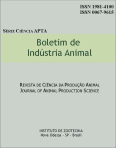Nitrogen rates for maximizing elephantgrass cv. Guaçu.yield during the dry season
Keywords:
Pennisetum purpureum, annual dry matter distribution, protein concentration, nitrogen extractionAbstract
An experiment was carried out at the “Instituto de Zootecnia, in an area of the Experimental Station of Brotas, SP, Brazil”, in a soil classified as Quartzipsamment, to evaluate dry matter yield and the seasonal distribution of the forage produced along the year, the crude protein content and the extraction of nitrogen by elephantgrass (Pennisetum purpureum Schum.) cv. Guaçu, from March 7, 1997 to March 7, 1998. The experiment was set in a complete randomized block design, with twelve replications. The treatments were four levels of N: 60, 120 180 and 240 kg per hectare, with nitro-chalk as source, applied in March 1997. The plots measured 6.0 X 4.8 m, with an useful harvesting area of 9.6 m2 (4.0 X 2.4 m). Forage was harvested five times along the year, in the following dates: 05/16/97, 09/18/97, 11/20/97, 01/22/98 and 03/07/98. The results indicated that the application of nitrogen at the end of the rainy season increased the dry matter yield in the first three cuts and in the whole year, and increased from 27 to 34% the proportion of forage produced in the dry season, when the nitrogen fertilization was increased from 60 to 240 kg ha-1 respectively. The concentration of crude protein and the extraction of nitrogen of the grass was positively affected by the nitrogen rates applied on March in the first, second and third cuts after the application.
Downloads
Downloads
Published
Issue
Section
License
Os autores não serão remunerados pela publicação de trabalhos, pois devem abrir mão de seus direitos autorais em favor deste periódico. Por outro lado, os autores ficam autorizados a publicar seus artigos, simultaneamente, em repositórios da instituição de sua origem, desde que citada a fonte da publicação original seja Boletim de Indústria Animal. A revista se reserva o direito de efetuar, nos originais, alterações de ordem normativa, ortográfica e gramatical, com vistas a manter o padrão culto da língua e a credibilidade do veículo. Respeitará, no entanto, o estilo de escrever dos autores. Alterações, correções ou sugestões de ordem conceitual serão encaminhadas aos autores, quando necessário. Nesses casos, os artigos, depois de adequados, deverão ser submetidos a nova apreciação. As opiniões emitidas pelos autores dos artigos são de sua exclusiva responsabilidade. Todo o conteúdo deste periódico, exceto onde está identificado, está licenciado sob a Licença Creative Commons Attribution (CC-BY-NC). A condição BY implica que os licenciados podem copiar, distribuir, exibir e executar a obra e fazer trabalhos derivados com base em que só se dão o autor ou licenciante os créditos na forma especificada por estes. A cláusula NC significa que os licenciados podem copiar, distribuir, exibir e executar a obra e fazer trabalhos derivados com base apenas para fins não comerciais.













